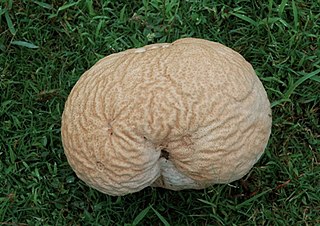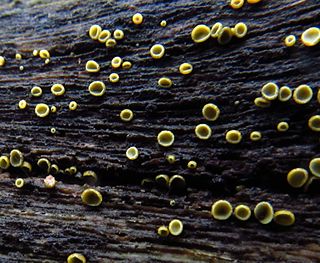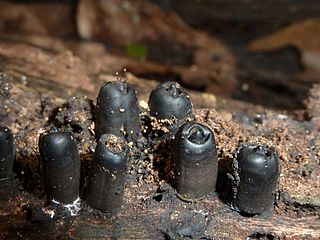
Calvatia is a genus of puffball mushrooms that includes the spectacular giant puffball C. gigantea. It was formerly classified within the now-obsolete order Lycoperdales, which, following a restructuring of fungal taxonomy brought about by molecular phylogeny, has been split; the puffballs, Calvatia spp. are now placed in the family Agaricaceae of the order Agaricales.

Nectria is a genus of Ascomycete fungi. They are most often encountered as saprophytes on decaying wood but some species can also occur as parasites of trees, especially fruit trees and a number of other hardwood trees. Some species are significant pests causing diseases such as apple canker, Nectria twig blight, and coral spot in orchards.

Hygrophorus is a genus of agarics in the family Hygrophoraceae. Called "woodwaxes" in the UK or "waxy caps" in North America, basidiocarps are typically fleshy, often with slimy caps and lamellae that are broadly attached to decurrent. All species are ground-dwelling and ectomycorrhizal and are typically found in woodland. Around 100 species are recognized worldwide. Fruit bodies of several species are considered edible and are sometimes offered for sale in local markets.
Capnodium footii is a sooty mold that develops in coconut leaves.

Gloeoporus is a genus of crust fungi in the family Irpicaceae. The genus has a widespread distribution.

Chlorosplenium is a genus of fungi in the family Dermateaceae. The genus was circumscribed by Elias Magnus Fries in 1849.

Camillea is a genus of fungi in the family Xylariaceae. Collectively, the 41 species in the genus have a widespread distribution, but are especially prevalent in tropical areas. Fruit bodies of Camillea species tend to be cylindrical in shape. The genus was originally circumscribed by Swedish mycologist Elias Fries in his 1849 work Summa vegetabilium Scandinaviae.

Arachnion is a genus of gasteroid fungi in the family Agaricaceae.

Catolechia is a genus of lichen-forming fungi in the family Rhizocarpaceae. It is a monotypic genus, containing the single species Catolechia wahlenbergii. The genus was circumscribed by German botanist Julius von Flotow in 1850. He did not assign a type species for the genus; Catolechia pulchellaA.Massal. (1852) was designated as the type by Gustav Wilhelm Körber in 1855. This species is synonymous with Catolechia wahlenbergii.

Chrysothrix is a genus of lichen-forming fungi in the family Chrysothricaceae. They are commonly called gold dust lichens or sulfur dust lichens, because they are bright yellow to greenish-yellow, sometimes flecked with orange, and composed entirely of powdery soredia. Apothecia are never present in North American specimens.

Colus hirudinosus is a species of stinkhorn fungus (Gasteromycete) found in Asia, Australia, northern Africa, and southern Europe. The fruit body has a short, thick stalk that divides into several spongy, wrinkled, stalk-like, orange to red columns that are united at the top, thus forming a lattice. The spores are found within the gleba—a dark, olive-brown slime that coats the inside of the columns. Spores are spread by insects that are attracted by the fetid smell of the gleba, eat the spores, and pass them on to germinate elsewhere.

Cymatoderma caperatum is a fungus species in the family Meruliaceae. It was originally described in 1849 as a species of Thelephora by Miles Joseph Berkeley and Camille Montagne. Derek Reid transferred it to Cymatoderma in 1956.

Niebla homalea is a species of fruticose lichen that grows on rocks in foggy areas along the Pacific Coast of North America, from Mendocino County, California south to Bahía de San Quintín on the main peninsula of Baja California, with an isolated occurrence further south on vertical rock faces above Punta Camachos, and other occurrences in the Channel Islands and on Guadalupe Island. The epithet homalea, given by Acharius, suggests it was in regard to the branches appearing flattened.
Lentinula reticeps is a species of agaric fungus in the family Omphalotaceae. It was originally described as Agaricus reticeps by French mycologist Camille Montagne in 1856. William Alphonso Murrill transferred it to the genus Lentinula in 1915.

Cantharellus guyanensis is a tropical South American species of mushroom-forming fungus in the chanterelle genus (Cantharellus), first described by Camille Montagne from French Guiana in 1854.

Polyporus leprieurii is a species of poroid fungus in the genus Polyporus. It was first described scientifically by French mycologist Camille Montagne.
C. theae can refer to a few different species (below). The specific epithet theae refers to tea, and many of the below are pathogens of the tea plant.

Solenopsora is a genus of lichen-forming fungi in the family Catillariaceae. It has 15 species, with a mostly Northern Hemisphere distribution.















